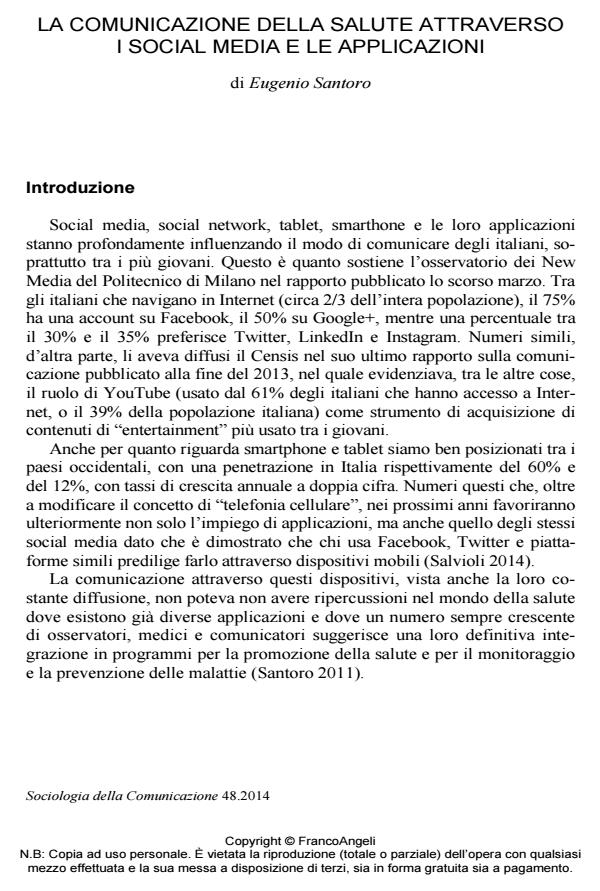How social media and apps can transform health communication
Journal title SOCIOLOGIA DELLA COMUNICAZIONE
Author/s Eugenio Santoro
Publishing Year 2014 Issue 2014/48 Language Italian
Pages 8 P. 39-46 File size 128 KB
DOI 10.3280/SC2014-048004
DOI is like a bar code for intellectual property: to have more infomation
click here
Below, you can see the article first page
If you want to buy this article in PDF format, you can do it, following the instructions to buy download credits

FrancoAngeli is member of Publishers International Linking Association, Inc (PILA), a not-for-profit association which run the CrossRef service enabling links to and from online scholarly content.
Social media, online social networks and apps for smartphones e tablets are changing the way to communicate health and health issues to consumers and health professionals. Medical societies, health organizations, hospitals and medical centers have included Facebook fan pages, Twitter profiles and YouTube channels in their communication strategies in order to reach a broader, more diverse audience potentially interested in what they usually publish. These tools provide also new mechanism to foster engagement and partnership with consumers, to change their behaviors and to fight against unhealthy lifestyles. For these reasons they should be to included in health promotion programs.
Keywords: Social media, social network, Facebook, Twitter, health promotion, smartphone
- Beaudoin C. E., Tao C. (2008), Modelling the impact of online cancer resources on supporters of cancer patients, «New Media Soc 2008», vol. 10, pp. 321-44.
- Cameron A. M., Massie A. B., Alexander C. E., Stewart B., Montgomery R. A., Benavides N. R., Fleming G. D., Segev D. L. (2013), Social Media and Organ Donor Registration: The Facebook Effect, «Am J Transplant», vol. 13, n. 8, pp. 2059-2065.
- Carter M. C., Burley V. J., Nykjaer C., Cade J. E. (2013), Adherence to a Smartphone Application for Weight Loss Compared to Website and Paper Diary: Pilot Randomized Controlled Trial, «J Med Internet Res», vol. 15, n. 4: e32.
- Centola D. (2011), An experimental study of homophily in the adoption of health behavior, «Science», vol. 334, pp. 1269-72.
- Coiera E. (2013), Social networks, social media, and social diseases, «BMJ», vol. 2013, n. 346, f3007.
- Fattori G., Pinelli N. (2013), Asl e ospedali ai tempi di Twitter, «Il Sole24Ore sanità », 23-29 luglio.
- Food and Drug Administration (2013), Mobile Medical Applications – Guidance for Industry and Food and Drug Administration Staff, FDA 25 settembre 2013.
- Huckvale K., Car M., Morrison C., Car J. (2012), Apps for asthma selfmanagement: a systematic assessment of content and tools, «BMC Med», vol.
- 10, n. 144. DOI: 10.1186/1741-7015-10-144.KirwanM.,VandelanotteC.,FenningA.,DuncanM.J.(2013),DiabetesSelf-ManagementSmartphoneApplicationforAdultsWithType1Diabetes:RandomizedControlledTrial,«JMedInternetRes»,vol.15,n.11:e23
- Klein T. (2014), Mayo Research Shows Cardiac Rehab Patients Who Use Smartphone App Recover Better, testo disponibile in http://newsnetwork.mayoclinic.org/discussion/cardiac-rehab-patients-who-use-smartphone-apprecover-better-mayo-clinic-research-shows (4 giugno 2014).
- Lau AYS et al. (2012), Impact of a web-based personally controlled health management system on influenza vaccination and health services utilization rates: a randomized controlled trial, «J Am Med Inform Assoc», vol. 19, n. 5, pp. 719-27.
- Ministero della Salute (2010), Linee guida per la comunicazione online in tema di tutela e promozione della salute, Roma, dicembre 2010.
- Moubarak G., Guiot A., Benhamou Y., Benhamou B., Hariri S. (2010), Facebook activity of residents and fellows and its impact on the doctor-patient relationship, «Journal of Medical Ethics», vol. 37, n. 2, pp. 101-4.
- Salvioli L. (2014), Audiweb svela i primi dati mobile: gli italiani navigano più da smartphone che pc, «Il Sole24Ore», 1° luglio 2014
- Santoro E. (2011), Web 2.0 e social media in medicina: come social network, wiki e blog trasformano la comunicazione, l’assistenza e la formazione in sanità, 2° ed., Il Pensiero Scientifico Editore, Roma.
- Santoro E. (2012), Social media, strutture sanitarie e cittadin, «Ricerca & Pratica», vol. 64, pp. 80.
- Steinhubl S. R., Muse E. D., Topol E. J. (2013), Can Mobile Health Technologies Transform Health Care?, «JAMA», vol. 13, n. 310, pp. 2395-6.
- Turner-McGrievy G. M., Tate D. F. (2013), Weight loss social support in 140 characters or less: use of an online social network in a remotely delivered weight loss intervention, «Translational Behavioral Medicine», vol. 3, pp. 287-94.
- Valle C. G., Tate D. F., Mayer D. K., Allicock M., Cai J. (2013), A randomized trial of a Facebook-based physical activity intervention for young adult cancer survivors, «J Cancer Surviv», vol. 7, n. 3, pp. 355-68.
- Weitzman E. R., Adida B., Kelemen S., Mandl K. D. (2011), Sharing data for public health research by members of an international online diabetes social network, «PLoS One», vol. 6, n. 4:e19256.
Eugenio Santoro, La comunicazione della salute attraverso i social media e le applicazioni in "SOCIOLOGIA DELLA COMUNICAZIONE " 48/2014, pp 39-46, DOI: 10.3280/SC2014-048004